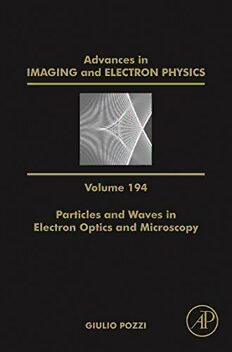
Particles and Waves in Electron Optics and Microscopy PDF
Preview Particles and Waves in Electron Optics and Microscopy
EDITOR-IN-CHIEF Peter W. Hawkes CEMES-CNRS Toulouse, France Coverphotocredit: TheoreticalsimulationofthecausticphenomenaappearingintheFresnelimageoftwo alignedbiasedtips.Distancebetweenthetips1.5μm,potentialdifference100V,defocus distance15mm,acceleratingelectronpotential300kV.Thesideoftheimageis1.6μm. AcademicPressisanimprintofElsevier 50HampshireStreet,5thFloor,Cambridge,MA02139,USA 525BStreet,Suite1800,SanDiego,CA92101-4495,USA TheBoulevard,LangfordLane,Kidlington,OxfordOX51GB,UK 125LondonWall,London,EC2Y5AS,UK Firstedition2016 ©2016ElsevierInc.Allrightsreserved. Nopartofthispublicationmaybereproducedortransmittedinanyformorbyanymeans, electronicormechanical,includingphotocopying,recording,oranyinformationstorageand retrievalsystem,withoutpermissioninwritingfromthepublisher.Detailsonhowtoseek permission,furtherinformationaboutthePublisher’spermissionspoliciesandour arrangementswithorganizationssuchastheCopyrightClearanceCenterandtheCopyright LicensingAgency,canbefoundatourwebsite:www.elsevier.com/permissions. Thisbookandtheindividualcontributionscontainedinitareprotectedundercopyrightby thePublisher(otherthanasmaybenotedherein). Notices Knowledgeandbestpracticeinthisfieldareconstantlychanging.Asnewresearchand experiencebroadenourunderstanding,changesinresearchmethods,professionalpractices, ormedicaltreatmentmaybecomenecessary. Practitionersandresearchersmustalwaysrelyontheirownexperienceandknowledgein evaluatingandusinganyinformation,methods,compounds,orexperimentsdescribed herein.Inusingsuchinformationormethodstheyshouldbemindfuloftheirownsafetyand thesafetyofothers,includingpartiesforwhomtheyhaveaprofessionalresponsibility. Tothefullestextentofthelaw,neitherthePublishernortheauthors,contributors,oreditors, assumeanyliabilityforanyinjuryand/ordamagetopersonsorpropertyasamatterof productsliability,negligenceorotherwise,orfromanyuseoroperationofanymethods, products,instructions,orideascontainedinthematerialherein. ISBN:978-0-12-804814-6 ISSN:1076-5670 ForinformationonallAcademicPresspublications visitourwebsiteathttp://store.elsevier.com/ Publisher:ZoeKruze AcquisitionEditor:PoppyGarraway EditorialProjectManager:BryantShellie ProductionProjectManager:MalathiSamayan CoverDesigner:MarkRogers TypesetbySPiGlobal,India DEDICATION To Emma v FOREWORD Myfirstencounterwithelectronopticswasformythesis,where,underthe supervisionofProfessorUgoValdr(cid:1)e,Icalculatedtheaberrationcoefficients of deflecting systems in order to evaluate their effect on the images of superconducting materials of the first kind by means of the shadow edge method.Mypreviousknowledgewaslimitedtobasicnotionsofgeometrical light optics, like the thin lens formula, so I had to enter a new and unexploredfield. My first guide was the book by Hall, Introduction to Electron Microscopy, which was soon followed by Glaser’s Grundlagen der Elektronenoptik, one of the cornerstones of electron optics. My scholastic knowledge of German was also very useful when I came across the beautiful electron interfero- metryexperimentsperformedinTu¨bingenbytheMo€llenstedtgroup,which IfoundinthePhysicsDepartmentlibraryintheattempttograspthemeaning of the Aharonov–Bohm effect from the experimental point of view. DuringafortuitoustrainjourneytoRomewithmyformerprofessorof experimentalphysics,GianFrancoMissiroli,westarteddiscussingthereal- izationofanelectroninterferenceexperimentfordidacticpurposes;andon the way back, we decided that it was worthwhile to build an electron biprism and start the experiments in Bologna. This was the beginning of a lifelong collaboration and friendship. The didactic experiment was soon followedbyresearchinthefieldofelectroninterferometry,whichhasnever been interrupted and still continues. However, thanks to the inspiration and imprinting of Gian Franco, the didacticandculturalaspectsofourresearchhasalwaysplayedapredominant role,oftenattheexpenseofthepurelyscientificpublicationsthataremore usefulfortheacademiccareer.Themoststrikingexampleofthisisthework incollaborationwithPierGiorgioMerlionthestatisticalaspectofelectron interferencephenomena,wherewepostponedsomeresearchworkinorder to realize the experiment of the buildup of the interference pattern by the hits of single electrons on the screen. Asauniversityteacher,Icouldalsodevelopmyinterestinbasicelectron optics and microscopyfrom the assignment of lectures. In spite of the very limitednumberofstudentsattendingthecourses,theinteractionwiththem stimulatedabetterunderstandingandnotamererepeatingofthearguments, so sometimes I was able to find new approaches to old topics and even to publish them. xi xii Foreword All this activity on these two fronts, university teaching and didactic research in collaboration with the Bologna group, finally found its natural outcomeinabook,madepossiblebymyearlyretirement,writteninItalian, entitledMicroscopiaeolografiaconelettroniandpublishedin2013byBononia University Press. The positive response from the Italian microscopy com- munity (and from foreign friends able to read a bit of Italian) convinced metowriteanEnglishversion.However,inordertomakethebookmore palatabletoaninternationalaudiencesomechangeswerenecessary.Inaddi- tiontominorrestyling,Icondensedintoonechaptertheresultsinthefield ofelectronholography,focusedthechapteronhighresolutionmoreonthe spherical aberration, and rewrote the chapters on the basic experiments on electron interference and their interpretation, including more updated material. This led to the change of the title. My impression is that today, many electron microscopists, more inter- estedintheapplications,arelookingattheinstrumentwithonlyafewbasic notionsoflightoptics,likemyselfatthebeginningofmycareer.Moreover, modernmicroscopesareextremelycomplicated,drivenmorebycomputer softwarethanbyhumans,sothattheoverallsensationisthatofablackbox beyond reach. It has thus lost the fascination of an instrument, which joins the basic physics that we study in the first university years to the most advanced physics represented by the gauge theories, of which the Aharonov–Bohmeffectisthemoststrikingexample.Notonlythat,every time we do experiments, we can literally see quantum physics in action. Ihopethatthisbookwillopenthewaytoabetterunderstandingofthe basic physics behind the instrument and an appreciation of its capabilities. PREFACE Although electron optics is now a mature subject, with textbooks at all levels,thereisalwayssomeaspectthatdeservesmoreattention.Here,Giulio Pozzifirstrehearsesthebasictheoryofelectronopticsbuthistextisunusual in that several chapters are devoted to electron interference phenomena: multipleslits,biprisms,theAharonov–Bohmeffectsandholography.Pozzi andhiscolleaguesinBolognaarewellknownfortheirworkonthesethemes anditisgoodtohavethisbroadaccount.Alastchapterexploresthespherical aberration coefficient from several viewpoints. IamverypleasedtoincludethisfreshtextintheseAdvances,inspiredby the original Italian version but with many revisions, and am confident that even seasoned electron opticians will find something new. Beginners will appreciate the detailed derivations of much of the theory. PETER HAWKES xiii FUTURE CONTRIBUTIONS S.Ando Gradientoperatorsandedgeandcornerdetection J.Angulo Mathematicalmorphologyforcomplexandquaternion-valuedimages D.Batchelor Softx-raymicroscopy E.BayroCorrochano Quaternionwavelettransforms C.Beeli Structureandmicroscopyofquasicrystals C.Bobisch,R.Mo¨ller Ballisticelectronmicroscopy F.Bociort Saddle-pointmethodsinlensdesign E.Bosch,I.Lazic High-resolutionSTEMandrelateddevelopments K.Bredies Diffusiontensorimaging A.Broers Aretrospective N.Chandra,R.Ghosh,(vol.196) Quantumentanglementinelectronoptics A.CornejoRodriguez,F.GranadosAgustin Ronchigramquantification K.Edee Unifiedformalismofmodalmethodsincomputationalelectromagnetics C.Edgcombe Electronphaseplates J.Elorza Fuzzyoperators R.G.Forbes Liquidmetalionsources P.L.Gai,E.D.Boyes Aberration-correctedenvironmentalmicroscopy xv xvi FutureContributions M.Haschke Micro-XRFexcitationinthescanningelectronmicroscope R.Herring,B.McMorran Electronvortexbeams M.S.Isaacson EarlySTEMdevelopment K.Ishizuka Contrasttransferandcrystalimages K.Jensen,D.Shiffler,J.Luginsland Physicsoffieldemissioncoldcathodes M.Jourlin,(vol.197) Logarithmicimageprocessing,theLIPmodel.Theoryandapplications U.Kaiser Thesub-A˚ngstro¨mlow-voltageelectronmicrocopeproject(SALVE) T.Kirk,(vol.196) Thenear-field-emissionscanningelectronmicroscope A.I.Kirkland,R.Clough,J.Mir Electrondetectors C.T.Koch In-lineelectronholography O.L.Krivanek Aberration-correctedSTEM M.Kroupa TheTimepixdetectoranditsapplications B.Lencova´ Moderndevelopmentsinelectronopticalcalculations H.Lichte Developmentsinelectronholography M.Matsuya CalculationofaberrationcoefficientsusingLiealgebra J.A.Monsoriu Fractalzoneplates L.Muray Miniatureelectronopticsandapplications S.A.Nepijko,V.G.Dyukov,G.Scho¨nhense,(vol.196) Voltagecontrastmodeinascanningelectronmicroscopeanditsapplications M.A.O’Keefe Electronimagesimulation FutureContributions xvii D.Paganin,T.Gureyev,K.Pavlov Intensity-linearmethodsininverseimaging N.Papamarkos,A.Kesidis TheinverseHoughtransform H.Qin Swarmoptimizationandlensdesign Q.Ramasse,R.Brydson TheSuperSTEMlaboratory B.Rieger,A.J.Koster Imageformationincryo-electronmicroscopy P.Rocca,M.Donelli Imagingofdielectricobjects J.Rodenburg Lenslessimaging J.Rouse,H.-n.Liu,E.Munro Theroleofdifferentialalgebrainelectronoptics J.Sa´nchez Fishervectorencodingfortheclassificationofnaturalimages P.Santi Lightsheetfluorescencemicroscopy P.Sciau Transmissionelectronmicroscopy,Emerginginvestigationsforculturalheritagematerials R.Shimizu,T.Ikuta,Y.Takai Defocusimagemodulationprocessinginrealtime T.Soma Focus-deflectionsystemsandtheirapplications I.J.Taneja Inequalitiesandinformationmeasures T.Tanigaki Aberration-correctedhigh-voltageelectronmicroscopy J.Valde´s RecentdevelopmentsconcerningtheSyst(cid:1)emeInternational(SI) ACKNOWLEDGMENTS TherearemanypeopleIwouldliketothankfortheirhelpwith,andinfluence on, my understandingofelectronopticsandmicroscopyduringmy lifelong activity.Ilimitmyselfheretothosewhocollaboratedmoredirectlywiththe papersformingthebackboneofthisbook:MarcoBeleggia,RaffaellaCapelli, ClaraCapiluppi,AnnamariaDiSebastiano,OrianoDonati,RitaFabbri,Pier Francesco Fazzini, Stefano Frabboni, Cesare Frigeri, Alessandro Gabrielli, Gian Carlo Gazzadi, Filippo Giorgi, Vincenzo Grillo, Takeshi Kawasaki, GiorgioMatteucci,FranciscoMedina,PierGiorgioMerli,AndreaMigliori, Gian Franco Missiroli, Michele Muccini, Enrico Nichelatti, Luca Ortolani, NicolaSempriniCesari,AkiraTonomura,FilippoUbaldi,UgoValdr(cid:1)e,Mas- simoVanzi,MauroVilla,andAntonioZoccoli.Lastbutnotleast,aparticular acknowledgmenttoStefanoPatuelli,whosetechnicalandgraphicalassistance over the years has been invaluable. CREDITS Thefollowingeditorsandscientificassociationsaregratefullyacknowl- edgedfortheirauthorizationtopublishfigurestakenfrompublishedpapers: Academic Press, American Association of Physics Teachers, American InstituteofPhysics,AmericanPhysicalSociety,Elsevier,InstituteofPhysics, Società Italiana di Fisica, Società Italiana di Scienze Microscopiche, and Springer Science + Business Media. xix
